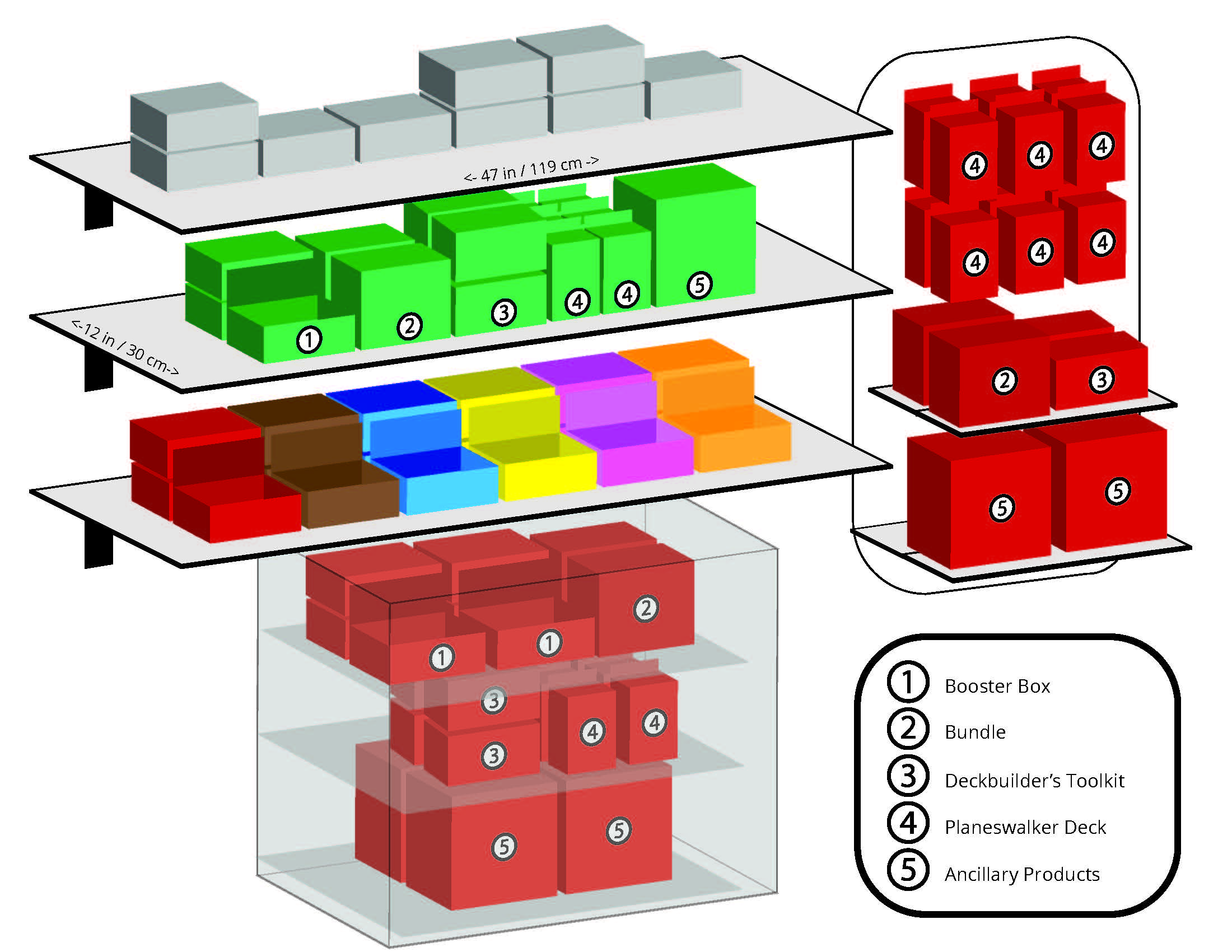Jan 11, 2019 — WPN Orientation
WPN Orientation: Sales Strategy
Jan 11, 2019 — WPN Orientation
WPN Orientation: Sales Strategy
You know your own business better than anyone, and we’d like to help you succeed. Take some time to get to know Wizards of the Coast products, and we’ll share some advice on creative ways for you to sell it.
This article will cover the following topics:
- Product Pathing
- Product Layout
- Monetization
- Standard Friendly Play
Product Pathing
Ask Yourself
What Magic product do you currently carry?
What Magic accessories do you carry?
Do you know what to sell to which players? How do you identify types of players based on interest?
Do you know all currently available Magic products?
Are you polling your players about their product preferences?
Educate yourself and your staff on appropriate Magic products for different types of customers. The key to understanding which products are better-suited for which players is starting with the experience level of those players.
New to Magic—Players who have never played Magic or have recently started.
Recommended Products: Welcome Deck, Spellslinger Starter Kit
Recommended Accessories: N/A
New players don’t need much to get started, and oftentimes less is better. Review the articles on New Player Acquisition to help these players get started with low barriers, and don’t overcomplicate your pitch by trying to sell products they might not be ready for.
Interested—Players who have started a collection already and engage in either beginner-friendly Magic play in the store or play occasionally at home with friends.
Recommended Products: Planeswalker Deck, Deck Builder’s Toolkit
Recommended Accessories: Sleeves, store-branded accessories.
Interested players are usually just a step above new players and might not yet engage in organized play.
These players may benefit from deckbuilding workshops and broader community events so they can hang out and play casually in your store. They finally express interest in making a purchase and don’t often have a broad collection to build from. Provide them with preconstructed decks and event experiences they can engage with right out of the box.
Engaged—Players who know the ins and outs of Magic and are involved in regular releases.
Recommended Products: Standard set Booster Packs, Bundle, Commander Decks
Recommended Accessories: Dice, sleeves, playmats, deck boxes, life pads, storage solutions
These are the players that have a quickly-growing collection and are likely already engaging in your organized play offerings.
When a player gets more comfortable with the game and is ready to start building their own decks, this is when a current booster pack becomes a much better recommendation. As they mature in experience, they’ll want storage for their cards as well as various accessories to customize their play experiences.
Super Fan—Players who are deeply involved with Magic culture and play a wide variety of formats.
Recommended Products: Signature Spellbook, Specialty Booster Packs
Recommended Accessories: Higher quality accessories, apparel, collector’s edition items, collection protection, inner sleeves.
Super Fans are the players who know exactly what they want, so in many ways they are the easiest group of players to sell to.
They probably know Magic and Magic products more than you do. Check in with these players from time to time to ask what they would like to buy from you and do the best you can to keep up with all new Magic releases, so you can be ready to offer the latest to your players.
Product Layout
Ask Yourself
Where is your product found?
Do you have a strategy for how your product is displayed?
What are your non-Magic displays like?

Many retail businesses have a clear strategy on how they present their product to customers. You want to make the product easy to browse and well organized, so customers can find the things they want faster.
Take a strategic approach to planning your product layout with something like a planogram, or a list of well-defined rules for product placement. Here are our layout recommendations for Magic products:
- Make new player products the easiest to find.
- Group current products together and feature them prominently, so a customer can identify the most recent expansion. These should be the primary movers in your inventory.
- Group older products together but separate from current product so it cannot be confused.
- Price your products clearly. Label the different product categories to help guide players to products that are more appropriate for them.
- Consider having some products within arm’s reach of your customers, so they can hold the product before they decide to buy it. This is best done with Planeswalker Decks and Deckbuilder’s Toolkits.
Monetizing Experiences
Ask Yourself
What creative ways do you sell product?
Have you considered creating unique event package offers?
Do you run special events to move sealed product?
How do you move out of season product?
Many businesses offer creative purchase opportunities to engage and excite their customer base, and hobby stores should be no different. Think about how fast food restaurants often offer combo meals to help a player get what they need quickly and consider how this model could apply to your store.
Bundled Offer Ideas
The following ideas present a concept that if you package everything a player needs into one price, you can make it easy for a player to get what they need without having to toil over multiple decisions.
Constructed Event Bundle—Event Ticket, Lifepad, Dice, Drink and Snack.
Draft Night Bundle—Thee booster packs, sleeves, a drink.
Starting Player Bundle—Planeswalker Deck, themed deck box and sleeves, Spindown life counter
Community Building Events
Unique event offerings that go beyond the standardized weekly tournament provide your store with additional monetization opportunities. Try some of these and poll your players to see what kinds of events work best for them, or try to capture new audiences with clever marketing.
Deckbuilding workshop—Create events that resemble classes. There are usually always players willing to either learn more or take the time to help others.
Pre-tournament trading hour—Set aside time for community-building and get more traffic before your main events begin.
After work/school/church draft—Run an event that’s convenient to specific groups of customers and caters to their schedule. If you make events easier to access, you can then capitalize on the increased traffic to sell product.
Creative Events
Find creative ways to move more product by leveraging events. Here are a few more ideas:
Sealed Deck with non-booster product. Run a tournament with the latest release of Planeswalker Decks or standalone deck products.
Product “free” with purchase into an event. Organize deckbuilder’s workshops, where event entry comes with a Deckbuilder’s Toolkit.
Ancillary product launch league. Run a month-long league with preconstructed Commander decks.
Flashback or Chaos Drafts. Host occasional drafts with out-of-Standard sets, either as it was originally meant to be drafted or combined with other inventory you have.
Standard-Friendly Play
Ask Yourself
Which format are you pushing around a new product release?
How do you and your staff talk about Standard?
Do you or your staff play Standard or have a Standard deck?
We talk a lot about lowering barriers to entry for all players and keeping play accessible, and the best way to accomplish this is by promoting a healthy Standard environment in your store.
As a business that carries and sells Magic product, you are an influencer in your customer’s purchase decisions, so it is important to be engaged and enthusiastic about it. Here’s our advice for a Standard-minded store.
Marketing
Align your sales push timing with Wizards of the Coast marketing efforts. Our marketing teams carefully craft messages to optimize player excitement in time with set releases. With the release of any new Standard set, work to build excitement around Standard and what the new cards mean for the format.
Wizards of the Coast works to sustain excitement of new set releases for at least a few weeks with event programs and other promotions. Lean into these programs so you can be in alignment, and to sell more product after the set has launched and momentum has slowed down.
Ancillary product marketing is intentionally short-lived. Push excitement around these products in the build-up to the release but remember that the audiences for these products may not be as wide as Standard releases.
Engagement
Build a Standard deck and encourage your staff to do the same. Take the opportunity to invite your players to play a quick game against you and use that time to check in with your players about their event interests. Your players are more likely to engage in Standard events if your store has a Standard-positive culture.
Be mindful of how you talk about Standard and current set releases. Do not engage in negative conversation surrounding products you are trying to sell.
Standard Positive Outlets
Here’s our final points of advice on Standard:
- If your players play Booster Draft, they are building a collection that they can then use to build a Standard deck.
- Try the Brawl format as a fun, casual way to engage with Standard cards.
- Standard is not synonymous with competitive play. Create low-pressure event opportunities for players and encourage them to experiment with new set releases. If your store struggles with this, host competitive events for Standard less often and casual events more often. See the Event Variety article for more information.
Top Takeaways
Take the time to understand our products and sell more effectively. Here are our top talking points.
- Sell more product by prioritizing Standard-friendly play. Standard and Draft encourage your players to interact with new products.
- Create clear product offers you can sell. Make it easy for a player to buy everything they need at once.
- Understand every product's purpose. Know what products to sell to any player at any stage in their Magic journey.
- Know how your product display influences purchases. Be strategic about product placement and make it easy to navigate for every customer.

